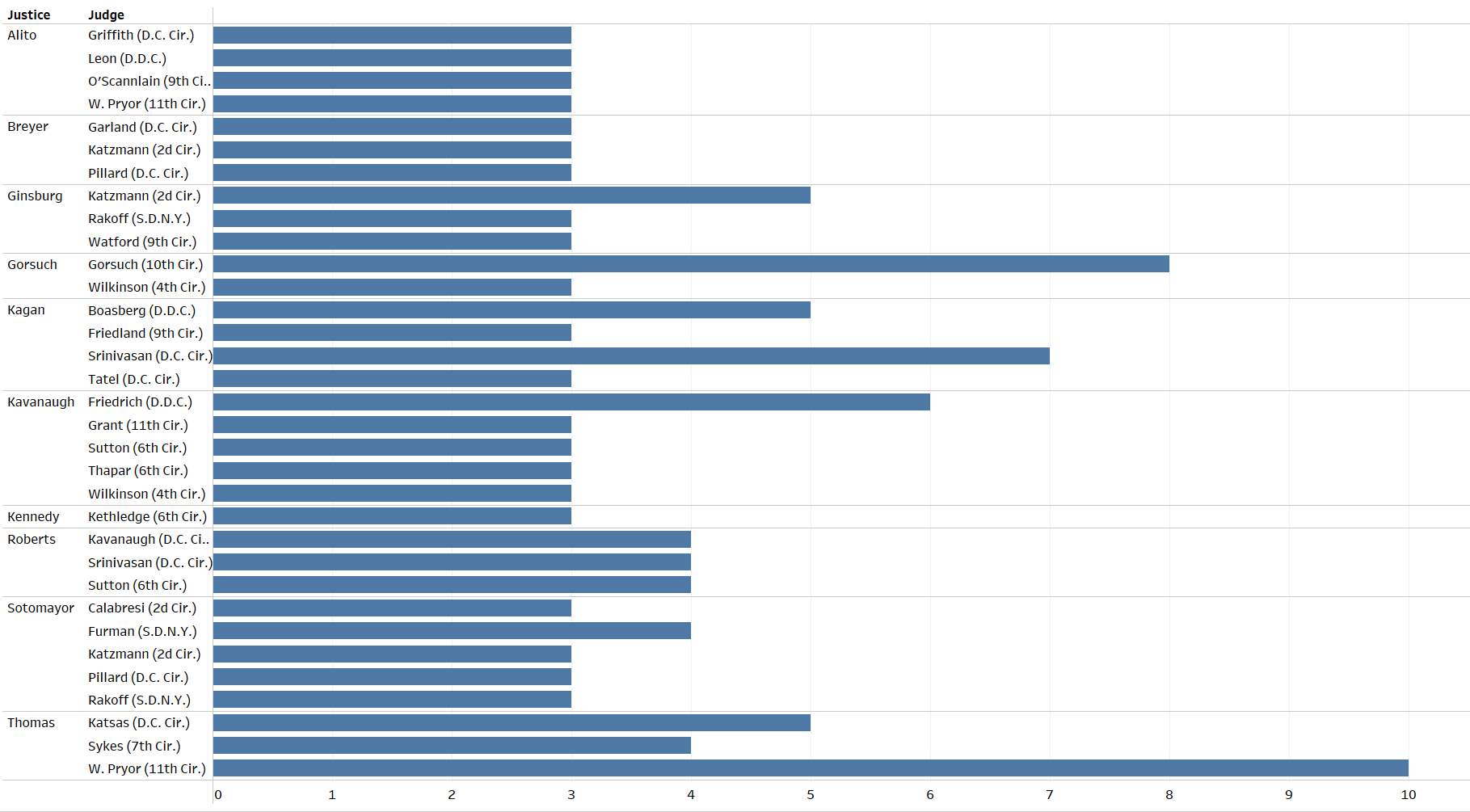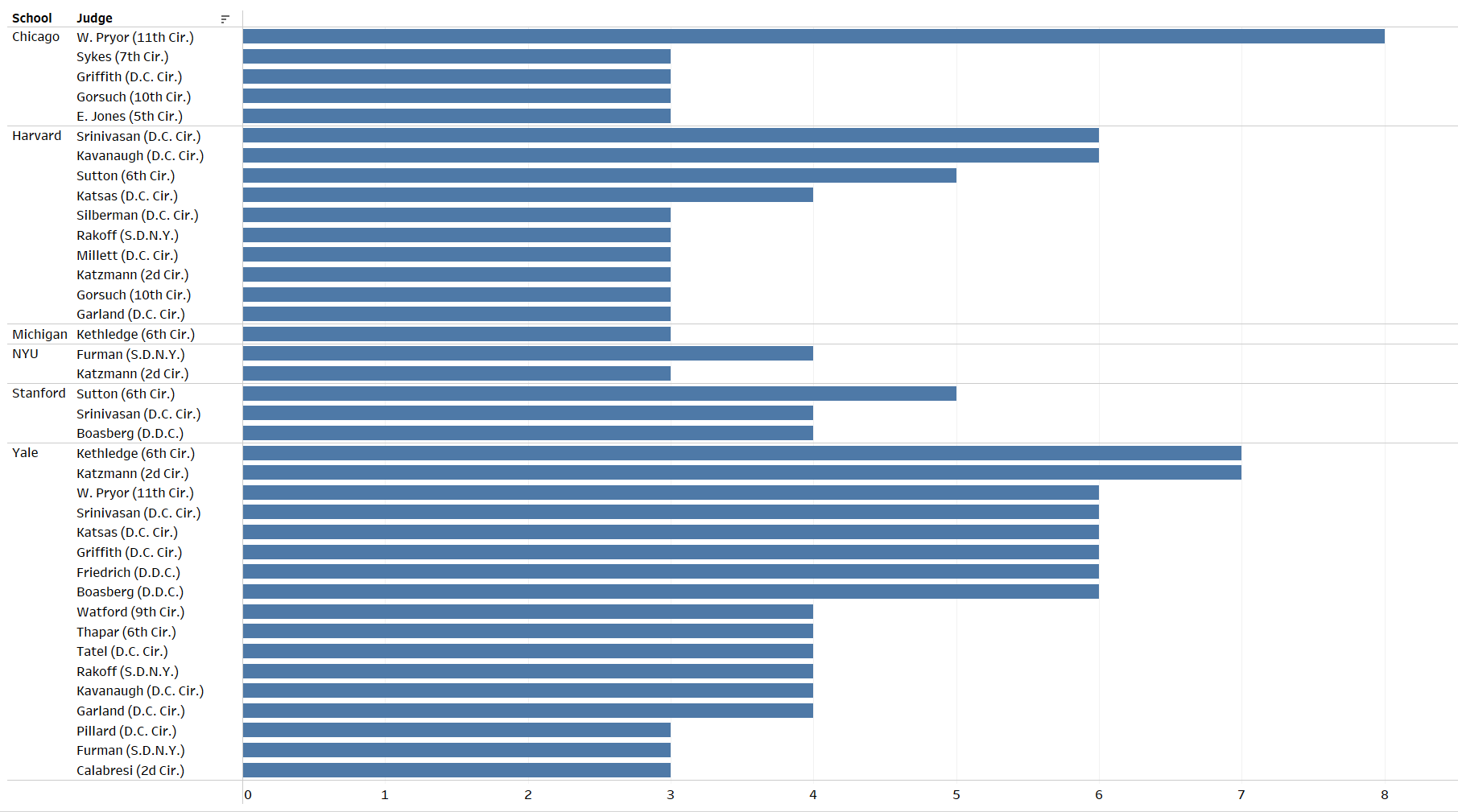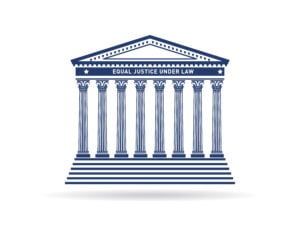When
confirmed
to
the
Supreme
Court
in
1962,
Justice
Byron
White
became
the
first
justice
ever
to
have
clerked
for
a
previous
justice,
as
White
clerked
for
Chief
Justice
Vinson
in
1946.
This
was
more
than
60
years
after
the
first
Supreme
Court
clerk
was
hired
by
Justice
Gray
in
1882
and
more
than
150
years
after
the
first
Supreme
Court
opinion.
Many
of
the
justices
who
were
confirmed
to
the
Court
after
White
did
not
previously
clerk
on
the
Supreme
Court.
Such
justices
include
Goldberg,
Fortas,
Thurgood
Marshall,
Burger,
Blackmun,
and
others.
Now
clerking
on
the
Court
seems
a
requisite
to
later
becoming
a
justice.
That
may
be
a
tad
hyperbolic
as
three
justices
—
Thomas,
Alito,
and
Sotomayor
—
were
not
Supreme
Court
clerks.
For
the
first
time
ever
though,
we
have
justices
replacing
justices
they
previously
clerked
for,
as
is
the
case
with
Justices
Kavanaugh,
who
clerked
for
Justice
Kennedy,
and
the
newly
confirmed
Justice
Jackson,
who
clerked
for
Justice
Breyer.
For
the
first
time
in
history,
we
now
have
two
justices
on
the
Court
who
previously
clerked
for
the
same
justice,
as
Justices
Gorsuch
and
Kavanaugh
both
clerked
for
Justice
Kennedy.
This
I
suppose
is
a
longwinded
way
to
opine
on
the
importance
of
Supreme
Court
clerkships
to
the
modern
Court
in
a
way
that
wasn’t
the
case
in
the
past.
This
is
not
a
judgment
call;
it
just
seems
to
be
the
state
of
affairs.
Who
might
fill
the
justices’
seats
in
the
future?
Although
the
pool
for
candidates
is
quite
large,
there
is
a
high
likelihood
that
they
will
have
previously
clerked
at
the
Supreme
Court
level.
To
gain
some
leverage
on
the
path
to
Supreme
Court
clerkships
I
ran
an
analysis
in
2016
that
looked
at
the
data
on
clerkships
between
2005
and
2016.
Some
years
have
passed
since
then
and
so
I
decided
to
assess
the
current
path
to
Supreme
Court
clerkships
based
on
law
schools
and
lower
court
clerkships.
So
where
are
clerks
currently
hailing
from?
First
a
look
at
the
law
schools
with
at
least
two
students
that
have
or
will
become
SCOTUS
clerks
in
2017
or
later:

Since
2017
more
SCOTUS
clerkships
have
gone
to
Yalies
than
to
students
from
any
other
school.
Not
surprisingly
Harvard
is
the
only
other
school
in
the
50-70
student
to
SCOTUS
clerkship
range.
After
these
two
obvious
choices,
University
of
Chicago
fared
well
as
did
Stanford
and
NYU.
Virginia,
Michigan,
Columbia,
and
Berkeley
fill
out
the
rest
of
the
schools
that
have
or
will
send
five
or
more
students
to
Supreme
Court
clerkships
from
2017
on.
What
about
lower
court
clerkships
including
those
on
both
federal
district
and
circuit
courts?
Only
one
clerk
in
the
dataset
did
not
clerk
below
the
Supreme
Court
level,
and
only
one
clerk
in
the
set
clerked
for
a
state
court
judge
below,
so
lower
federal
court
clerkships
are
almost
a
necessity
to
go
on
to
a
SCOTUS
clerkship.
Below
are
judges
with
at
least
five
clerks
who
went
or
are
going
on
to
clerkships
on
the
Supreme
Court.

The
ideological
nature
of
the
relationship
between
feeder
judges
(those
from
appeals
courts)
or
district
court
judges
and
Supreme
Court
Justices
is
readily
apparent.
Judge
Srinivasan
on
the
D.C.
Circuit
was
the
other
likely
candidate
along
with
Merrick
Garland
for
nomination
to
fill
the
seat
vacated
by
Justice
Scalia.
Srinivasan
tracked
a
bit
more
to
the
left
of
Garland
when
Garland
also
sat
on
the
D.C.
Circuit.
On
the
other
end
of
the
spectrum
Judge
William
Pryor
who
comes
next
on
the
graph
is
a
judge
at
the
right
end
of
the
ideological
spectrum.
Later
in
this
post
I
look
at
which
justices
are
taking
clerks
from
the
various
lower
court
judges.
Interestingly,
even
though
Justice
Kavanaugh
has
been
on
the
Court
since
2018,
his
former
clerks
made
him
the
fourth
highest
ranking
feeder
judge
since
2017.
Since
most
of
the
SCOTUS
clerks
in
the
data
clerk
for
multiple
judges
below
some
connective
tissue
will
be
helpful
here
–
namely
a
look
at
the
most
common
sequence
of
clerkships.
In
the
graph
below
Judge
1
is
for
a
first
clerkship
and
Judge
2
a
second
clerkship
(the
one
preceding
a
Supreme
Court
clerkship).
The
observations
included
are
only
for
sequences
followed
by
two
or
more
clerks.

Some
notable
points
about
this
graph.
First,
there
are
several
clerks
with
sequences
including
multiple
appeals
court
judges
but
no
district
court
judge.
Second,
the
most
common
sequences
are
(1)
Judge
Rakoff
from
the
district
court
to
Judge
Katzmann
on
the
second
circuit
and
(2)
Judge
Boasberg
from
the
district
court
level
and
Judge
Srinivasan
on
the
D.C.
Circuit.
Third,
only
one
circuit
judge,
Judge
Watford,
is
connected
to
multiple
district
court
judges,
each
with
multiple
observations.
Now
a
look
at
the
relationship
between
justices
and
feeder
judges
/
district
court
judges.

The
most
apparent
relationship
is
between
Justice
Thomas
and
Judge
William
Pryor.
Thomas
also
pulls
a
high
number
of
clerks
from
Judge
Sykes
on
the
7th
Circuit
and
from
Judge
Katsas
on
the
D.C.
Circuit.
Justice
Gorsuch
has
pulled
the
highest
number
of
previous
clerks
from
those
who
previously
clerked
for
him
on
the
10th
Circuit.
Other
notable
relationships
include
Justice
Kagan
and
Judge
Srinivasan,
and
former
Justice
Ginsburg
and
Judge
Katzmann.
Chief
Justice
Roberts
has
a
strong
balance
between
the
left
and
right
with
an
equal
number
of
clerks
coming
from
Justice
Kavanaugh
(when
he
sat
on
the
D.C.
Circuit),
Judge
Srinivasan,
and
Judge
Sutton
from
the
6th
Circuit.
How
about
the
relationships
between
the
justices
and
law
schools
where
the
clerks
previously
studied
(with
a
minimum
of
four
clerks
from
a
given
school)?

Several
of
the
justices
including
Alito,
Breyer,
Ginsburg,
Kavanaugh,
Kennedy,
and
Sotomayor
took
more
clerks
from
Yale
than
from
other
schools.
Justices
Barrett,
Gorsuch,
and
Thomas
all
have
more
clerks
from
the
University
of
Chicago
than
from
any
of
the
other
schools.
Roberts
has
the
most
clerks
from
any
one
school
than
any
of
the
other
justices.
These
20
clerks
are
from
Harvard
Law
School.
Justices
Kagan
and
Kavanaugh
also
have
more
clerks
that
previously
attended
Harvard
Law
School
than
any
of
the
other
schools.
We
can
slice
these
data
a
few
more
ways.
Next
a
look
at
the
relationship
between
the
lower
court
judges
and
the
law
schools.
Many
of
these
relationships
should
seem
obvious
based
on
where
the
justices
find
the
majority
of
their
clerks.
This
graph
includes
feeder
and
district
court
judges
with
at
least
three
SCOTUS
clerks
from
a
given
school.

The
strongest
relationship
is
between
Judge
W.
Pryor
and
University
of
Chicago
which
seems
intuitive
given
the
relationships
between
several
of
the
justices,
Judge
Pryor,
and
University
of
Chicago.
Judges
Kethledge
and
Katzmann
each
have
seven
clerks
from
Yale
who
have
or
will
clerk
at
the
Supreme
Court
level.
Judge
Sutton
has
taken
more
clerks
from
Stanford
who
will
or
have
clerked
at
the
Supreme
Court
level
than
from
other
schools.
Lastly,
Judge
Srinivasan
and
then
Judge
Kavanaugh
had
more
clerks
from
Harvard
who
moved
or
are
moving
on
to
Supreme
Court
clerkships
than
from
other
schools.
Finally,
we
can
pool
this
information
together
to
look
at
the
tripartite
relationship
between
law
school,
judge,
and
justice.
The
following
graph
looks
at
this
relationship
based
on
a
minimum
of
two
Supreme
Court
clerks
who
proceeded
in
such
a
fashion.

The
pull
of
Yale
Law
School
is
evident
in
the
above
graph.
The
strongest
relationship
is
between
Justice
Kavanaugh,
Yale
Law
School,
and
Judge
Friedrich
on
the
District
Court
of
D.C.
The
next
strongest
relationship
is
between
Harvard,
Judge
Sutton,
and
Chief
Justice
Roberts.
Other
notable
relationships
include
(1)
Yale,
Judge
W.
Pryor,
and
Justice
Alito,
(2)
both
Harvard
and
Stanford,
Judge
Srinivasan,
and
Justice
Kagan,
and
(3)
district
court
Judge
Furman,
NYU,
and
Justice
Sotomayor
to
name
a
few.
Without
running
the
network
analysis
as
I
did
in
the
previous
post,
Yale
Law
School
and
Judge
Srinivasan
should
support
the
strongest
combination
to
make
it
to
the
Supreme
Court
even
though
none
of
the
three-part
relationships
include
that
combination.
The
elite
schools
are
still
the
powerhouses
churning
out
Supreme
Court
clerks
but
there
seems
to
be
more
parity
below
Harvard
and
Yale
than
existed
previously.
The
University
of
Chicago
Law
School
is
especially
notable
for
both
its
total
number
of
former
students
becoming
Supreme
Court
clerks
and
the
strong
ties
between
Chicago,
certain
lower
court
judges,
and
particular
justices.
Ideology
in
lower
court
judges
seems
to
play
a
large
role
in
the
process
of
reaching
a
Supreme
Court
clerkship
as
the
justices
appear
to
pull
clerks
strategically
from
particular
lower
court
judges.
If
the
justices
maintain
the
polarized
ideologic
makeup
of
the
Court
moving
forward
we
should
expect
to
continue
seeing
these
strategic
ideologic
choices.
Read
more
at
Empirical
SCOTUS…
Adam
Feldman
runs
the
litigation
consulting
company
Optimized
Legal
Solutions
LLC.
For
more
information
write
Adam
at afeldman@thejurislab.com. Find
him
on
Twitter: @AdamSFeldman.

